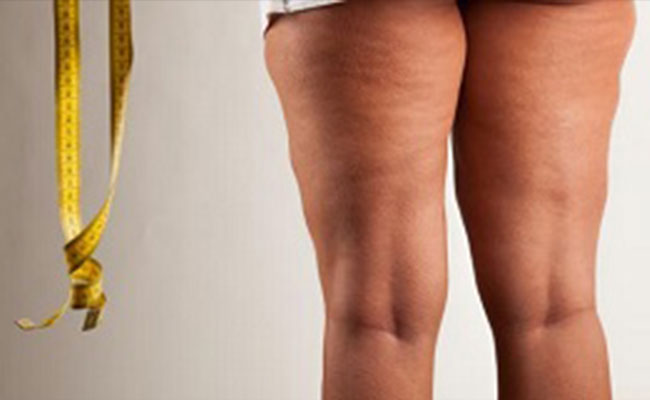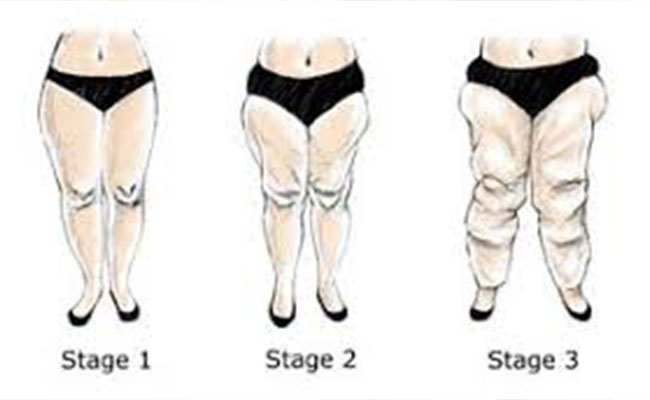If you want to be truly beautiful. Contact Cosmetics and Regen Med Training:We Provide Regenerative and Beautifying Plastic and Cosmetic Surgery services for all over the world
Contact Dr. DR. TAWFIK SEFRIOUI for a personal consultation to discuss how to become a better looking you!
OVERVIEW

Lipedema (painful fat syndrome) is a chronic disease that occurs mostly in females. It is characterized by bilateral, symmetrical fatty tissue excess, mainly in the hip region, upper and lower leg areas and combined with a tendency for leg swelling that worsens with standing. In male patients lipedema is extremely rare. Lipedema is often misdiagnosed as bilateral lower extremity lymphedema or as simple obesity.
Causes of Lipedema : The etiology of lipedema and other types of fatty tissue enlargement is still unknown though a genetic cause is suspected. Other possible causes of lipedema include metabolic, inflammatory, or hormonal involvement.
Symptoms: Symptoms vary significantly by person, not all people have all symptoms :
- Symmetrical presentation, involving both legs
- Pain in soft tissues at rest, and upon walking or when touched; hypersensitivity to touch
- Accumulation of lipedemic fat from waist to knees or ankles, sometimes leaving a distinct fat ring above the ankle, leaving the feet unaffected
- Hyper-mobility
- Fat pads above, inside and below knees, and in outer region of upper thighs 1
- Fat lobes or pads may put stress on joints causing abnormal gait and/or increased joint pain
- Knee problems which may lead to gait impairment
- Accumulation of lipedemic fat in the upper arms, sometimes leaving large amounts of arm fat hanging when arm is outstretched, research reports a range of 30-90% of people with lipedema are affected in their arms
- Accumulation of lipedemic fat in the arms, sometimes creating a blouse effect as the distinct fat ring above the wrist forms
- Loss of skin elasticity
- Non-pitting edema initially; later may become lipo-lymphedema (Stage IV)
- Pitting edema can happen with prolonged orthostasis and should resolve when legs are elevated
- Caloric restrictive diets have little effect on lipedemic fat
- Easy bruising
- Negative Stemmer’s sign on feet and hands
- Decreased skin temperature in the limbs
- General fatigue
- Sensitivity to pressure
- The limb texture is rubbery
- Age of onset is usually during puberty, pregnancy or menopause
- Onset or exacerbation can present after surgery with general anesthesia
- Feet and hands are generally unaffected before development of Lipo-Lipedema (Stage IV)
- Early stages: The upper body may remain slender as the lower body enlarges and fat accumulates in the hips, thighs and legs
- Later stages: lipedemic fat also may accumulate in the chest, torso, abdomen and upper extremities
- Obvious lymphatic involvement is present in the later stages
- Chronic pain and embarrassment may lead to depression and/or eating disorders
- Progressive deterioration of mobility if left untreated
- Fat may become fibrotic
- Low Vitamin D, iron and/or B12
- Sometimes pockets of fat/fluid appear below the knee
STAGES OF LIPEDEMA

Stage I
- Skin is smooth
- Swelling increases during the day and may resolve with rest and elevation
- Responds well to treatment
Stage II
- Skin has indentations
- Lipomas may develop
- Eczema and erysipelas may be present
- Swelling increases during the day, with less resolution after rest and elevation
- May respond well to treatment
Stage III
- Hardened connective tissue/fibrosclerosis
- Swelling consistently present
- Large masses of skin and fat that overhang
- Less responsive to some treatment modalities
Stage IV
- Fibrosclerosis, possibly elephantiasis
- Swelling consistently present
- Larger masses of skin and fat that overhang
- Also known as Lipo-Lymphedema
- Less responsive to some treatment modalities
TREATMENT
Even though lipedema was first formally identified in the U.S. at the Mayo Clinic in 1940, most physicians are not readily familiar with the disorder. There is no cure yet identified for lipedema, however, early detection and treatment can significantly reduce the debilitation of the patient. Early weight and diet changes through nutrition and exercise may be helpful in reducing non-lipedema fat and reducing inflammation. This approach may possibly prevent the lower body from enlarging as much as it would if the patient were to become obese. However, even with strict diet and exercise regimens the disease may progress and further treatments may be necessary.
While there is no proven effective treatment for lipedema, the swelling may be somewhat managed with Compression garments, certain Products and Treatments, Manual Lymphatic Drainage and/or Complete Decongestive Therapy. Compression garments and other products can further help reduce the swelling and lessen the fluid return. Unfortunately, these garments may not be well tolerated by all patients if the patient experiences pain. It is important to work with a qualified provider to find the correct garments as the wrong garment can compress the initial lymphatic openings inhibiting lymph flow through the lymphatic vessels.
Liposuction as a treatment for lipedema was developed in Germany in the late 1980s (6) and is becoming more common. While it has helped some patients when done by a skilled surgeon knowledgeable about lipedema, very few physicians have the knowledge and experience about how to treat these patients and technically skilled to perform this surgery on the legs and the arms, this technique needs years of experience to learn and to perform without complication . Given the fact that liposuction is a surgery and all surgeries come with risk, consulting one’s primary care physician before surgery is recommended. Currently, different liposuction procedures used for lipedema patients are available but not all surgeries are suitable for all patients. Water Assisted Liposuction (WAL) is the procedure by excellence the routinely and successfully being performed in Few countries around the world and only handful surgeons are well trained to perform this procedure for lipedema patients. Patients are encouraged to consult with multiple physicians who perform liposuction procedures to gain insight into the physician’s approach, outcomes and technique.
Lipedema is sometimes accompanied by co-morbidities, often secondary diseases, which complicate the patient’s health. Articular and venous diseases, lymphedema, obesity, and psychosocial disorders are often seen with lipedema patients. Medications for pain control, anxiety and depression are common prescriptions in this population. Some patients report reduction in symptoms with certain medicines and supplements. Gastric bypass or Bariatric surgery will not reduce the lipedema fat, though it may help ease some of the comorbidities that may be present.
Please if you think you may have this disease, call Our medical facility to set your appointment for a consult with Dr Tawfik Sefrioui who is among the few expert on lipedema worldwide.’
